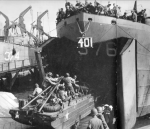NavSource Online: Amphibious Photo Archive

Lost to enemy torpedo attack, 9 June 1944
USS LST-376




International Radio Call Sign:
November - Papa - Zulu - Golf
NPZG
Awards, Citations and Campaign Ribbons
Precedence of awards is from left to right
American Campaign Medal - European-Africa-Middle East Campaign Medal (3) - World War II Victory Medal
LST-1 Class Tank Landing Ship
Laid down, 25 November 1942, at Bethlehem Steel Co., Quincy, MA.
Launched, 1 February 1943
Commissioned USS LST-376, 5 February 1943, LT. R M. Wasarhaley, USNR, in command
During World War II USS LST-376 was assigned to the Europe-Africa-Middle East Theater and participated in the following campaigns:
Europe-Africa-Middle East Campaigns |
| Campaigns and Dates |
Campaigns and Dates |
| Sicilian occupation, 9 to 15 July 1943
| Invasion of Normandy, 6 to 25 June 1944
|
| Salerno landings, 9 to 21 September 1943
| |
USS LST-376 was torpedoed and sunk by a German surface craft in the English Channel, 9 June 1944
Struck from the Naval Register, 28 June 1944
USS LST-376 earned three battle stars for World War II service
Specifications:
Displacement
1,625 t.(lt)
4,080 t.(fl) (sea-going draft w/1675 ton load)
2,366 t. (beaching displacement)
Length 328' o.a.
Beam 50'
Draft
light 2' 4" fwd, 7' 6" aft
sea-going 8' 3" fwd, 14' 1" aft
landing 3' 11" fwd, 9' 10" aft (landing w/500 ton load)
limiting 11' 2"
maximum navigation 14' 1"
Speed 11.6 kts. (trial)
Endurance 24,000 miles @ 9kts. while displacing 3960 tons
Complement
13 officers
104 enlisted
Troop Accommodations
16 officers
147 enlisted
Boats 2 LCVP
Cargo Capacity (varied with mission - payloads between 1600 and 1900 tons)
Typical loads
One Landing Craft Tank (LCT), tanks, wheeled and tracked vehicles, artillery, construction equipment and military supplies. A ramp or elevator forward allowed vehicles access to tank deck from main deck
Additional capacity included sectional pontoons carried on each side of vessel amidships, to either build Rhino Barges or use as causeways. Married to the bow ramp, the causeways would enabled payloads to be delivered ashore from deeper water or where a beachhead would not allow the vessel to be grounded forward after ballasting
Armament (varied with availability when each vessel was outfitted. Retro-fitting was accomplished throughout WWII. The ultimate armament design for United States vessels was
2 - Twin 40MM gun mounts w/Mk. 51 directors
4 - Single 40MM gun mounts
12 single 20MM gun mounts
Fuel Capacity
Diesel 4,300 Bbls
Propulsion
two General Motors 12-567A, 900hp Diesel engines
single Falk Main Reduction Gears
three Diesel-drive 100Kw 230V D.C. Ship's Service Generators
two propellers, 1,700shp
twin rudders
Click On Image
For Full Size Image |
Size |
Image Description |
Source |
 |
96k |
USS LST-376 embarking a DUKW amphibious truck at an unidentified English port prior to the Invasion of Normandy. USS LST-374 is alongside to starboard. |
Robert Hurst |
USS LST-376
Dictionary of American Naval Fighting Ships (DANFS)
Commanding Officers
|
| 01 | LT. Wasarhaley, R. M., USNR | 5 February 1943 - 9 June 1944 |
|
| | Courtesy Wolfgang Hechler and Ron Reeves |
Crew Contact And Reunion Information
U.S. Navy Memorial Foundation - Navy Log
Additional Resources and Web Sites of Interest
The USS LST Ship Memorial
LST Home Port
State LST Chapters
United States LST Association
This page is created and maintained by Gary P. Priolo

|
Last Updated 22 August 2014
| 
